Dongchao Yang
UniSep: Universal Target Audio Separation with Language Models at Scale
Mar 31, 2025Abstract:We propose Universal target audio Separation (UniSep), addressing the separation task on arbitrary mixtures of different types of audio. Distinguished from previous studies, UniSep is performed on unlimited source domains and unlimited source numbers. We formulate the separation task as a sequence-to-sequence problem, and a large language model (LLM) is used to model the audio sequence in the discrete latent space, leveraging the power of LLM in handling complex mixture audios with large-scale data. Moreover, a novel pre-training strategy is proposed to utilize audio-only data, which reduces the efforts of large-scale data simulation and enhances the ability of LLMs to understand the consistency and correlation of information within audio sequences. We also demonstrate the effectiveness of scaling datasets in an audio separation task: we use large-scale data (36.5k hours), including speech, music, and sound, to train a universal target audio separation model that is not limited to a specific domain. Experiments show that UniSep achieves competitive subjective and objective evaluation results compared with single-task models.
MoonCast: High-Quality Zero-Shot Podcast Generation
Mar 19, 2025Abstract:Recent advances in text-to-speech synthesis have achieved notable success in generating high-quality short utterances for individual speakers. However, these systems still face challenges when extending their capabilities to long, multi-speaker, and spontaneous dialogues, typical of real-world scenarios such as podcasts. These limitations arise from two primary challenges: 1) long speech: podcasts typically span several minutes, exceeding the upper limit of most existing work; 2) spontaneity: podcasts are marked by their spontaneous, oral nature, which sharply contrasts with formal, written contexts; existing works often fall short in capturing this spontaneity. In this paper, we propose MoonCast, a solution for high-quality zero-shot podcast generation, aiming to synthesize natural podcast-style speech from text-only sources (e.g., stories, technical reports, news in TXT, PDF, or Web URL formats) using the voices of unseen speakers. To generate long audio, we adopt a long-context language model-based audio modeling approach utilizing large-scale long-context speech data. To enhance spontaneity, we utilize a podcast generation module to generate scripts with spontaneous details, which have been empirically shown to be as crucial as the text-to-speech modeling itself. Experiments demonstrate that MoonCast outperforms baselines, with particularly notable improvements in spontaneity and coherence.
InSerter: Speech Instruction Following with Unsupervised Interleaved Pre-training
Mar 04, 2025Abstract:Recent advancements in speech large language models (SpeechLLMs) have attracted considerable attention. Nonetheless, current methods exhibit suboptimal performance in adhering to speech instructions. Notably, the intelligence of models significantly diminishes when processing speech-form input as compared to direct text-form input. Prior work has attempted to mitigate this semantic inconsistency between speech and text representations through techniques such as representation and behavior alignment, which involve the meticulous design of data pairs during the post-training phase. In this paper, we introduce a simple and scalable training method called InSerter, which stands for Interleaved Speech-Text Representation Pre-training. InSerter is designed to pre-train large-scale unsupervised speech-text sequences, where the speech is synthesized from randomly selected segments of an extensive text corpus using text-to-speech conversion. Consequently, the model acquires the ability to generate textual continuations corresponding to the provided speech segments, obviating the need for intensive data design endeavors. To systematically evaluate speech instruction-following capabilities, we introduce SpeechInstructBench, the first comprehensive benchmark specifically designed for speech-oriented instruction-following tasks. Our proposed InSerter achieves SOTA performance in SpeechInstructBench and demonstrates superior or competitive results across diverse speech processing tasks.
Audio-FLAN: A Preliminary Release
Feb 23, 2025Abstract:Recent advancements in audio tokenization have significantly enhanced the integration of audio capabilities into large language models (LLMs). However, audio understanding and generation are often treated as distinct tasks, hindering the development of truly unified audio-language models. While instruction tuning has demonstrated remarkable success in improving generalization and zero-shot learning across text and vision, its application to audio remains largely unexplored. A major obstacle is the lack of comprehensive datasets that unify audio understanding and generation. To address this, we introduce Audio-FLAN, a large-scale instruction-tuning dataset covering 80 diverse tasks across speech, music, and sound domains, with over 100 million instances. Audio-FLAN lays the foundation for unified audio-language models that can seamlessly handle both understanding (e.g., transcription, comprehension) and generation (e.g., speech, music, sound) tasks across a wide range of audio domains in a zero-shot manner. The Audio-FLAN dataset is available on HuggingFace and GitHub and will be continuously updated.
ATRI: Mitigating Multilingual Audio Text Retrieval Inconsistencies by Reducing Data Distribution Errors
Feb 22, 2025Abstract:Multilingual audio-text retrieval (ML-ATR) is a challenging task that aims to retrieve audio clips or multilingual texts from databases. However, existing ML-ATR schemes suffer from inconsistencies for instance similarity matching across languages. We theoretically analyze the inconsistency in terms of both multilingual modal alignment direction error and weight error, and propose the theoretical weight error upper bound for quantifying the inconsistency. Based on the analysis of the weight error upper bound, we find that the inconsistency problem stems from the data distribution error caused by random sampling of languages. We propose a consistent ML-ATR scheme using 1-to-k contrastive learning and audio-English co-anchor contrastive learning, aiming to mitigate the negative impact of data distribution error on recall and consistency in ML-ATR. Experimental results on the translated AudioCaps and Clotho datasets show that our scheme achieves state-of-the-art performance on recall and consistency metrics for eight mainstream languages, including English. Our code will be available at https://github.com/ATRI-ACL/ATRI-ACL.
A Comparative Study of Discrete Speech Tokens for Semantic-Related Tasks with Large Language Models
Nov 13, 2024Abstract:With the rise of Speech Large Language Models (Speech LLMs), there has been growing interest in discrete speech tokens for their ability to integrate with text-based tokens seamlessly. Compared to most studies that focus on continuous speech features, although discrete-token based LLMs have shown promising results on certain tasks, the performance gap between these two paradigms is rarely explored. In this paper, we present a fair and thorough comparison between discrete and continuous features across a variety of semantic-related tasks using a light-weight LLM (Qwen1.5-0.5B). Our findings reveal that continuous features generally outperform discrete tokens, particularly in tasks requiring fine-grained semantic understanding. Moreover, this study goes beyond surface-level comparison by identifying key factors behind the under-performance of discrete tokens, such as limited token granularity and inefficient information retention. To enhance the performance of discrete tokens, we explore potential aspects based on our analysis. We hope our results can offer new insights into the opportunities for advancing discrete speech tokens in Speech LLMs.
Codec-SUPERB @ SLT 2024: A lightweight benchmark for neural audio codec models
Sep 21, 2024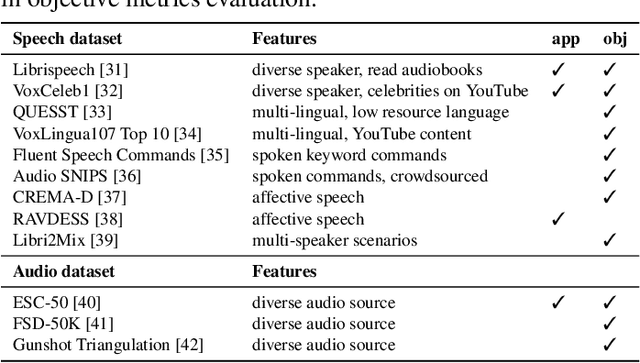
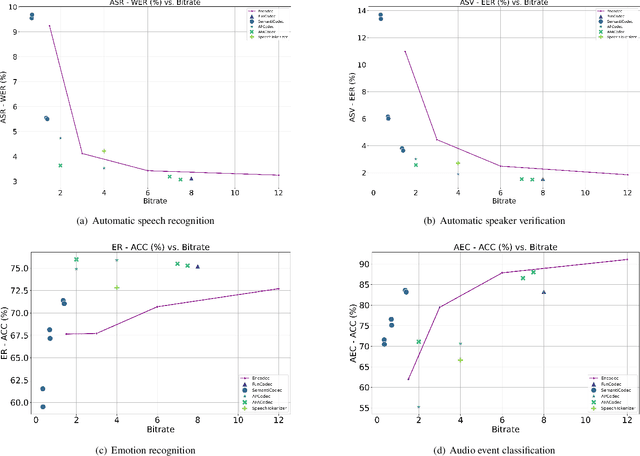
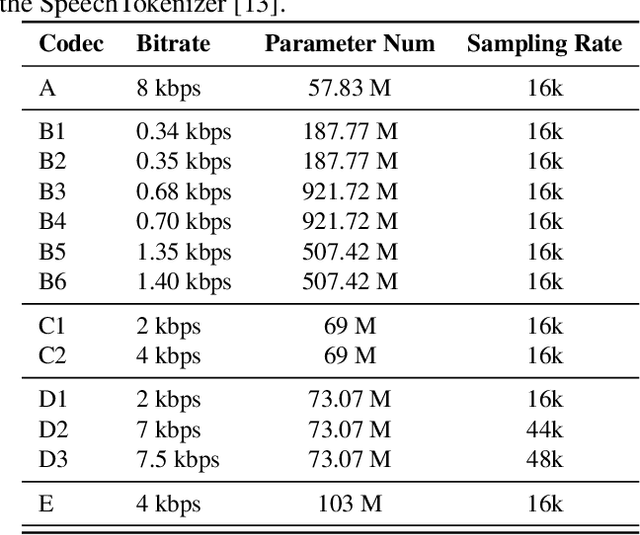
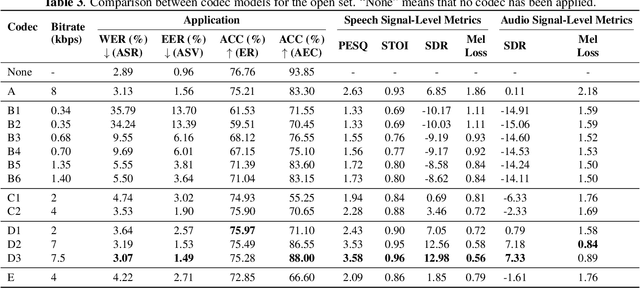
Abstract:Neural audio codec models are becoming increasingly important as they serve as tokenizers for audio, enabling efficient transmission or facilitating speech language modeling. The ideal neural audio codec should maintain content, paralinguistics, speaker characteristics, and audio information even at low bitrates. Recently, numerous advanced neural codec models have been proposed. However, codec models are often tested under varying experimental conditions. As a result, we introduce the Codec-SUPERB challenge at SLT 2024, designed to facilitate fair and lightweight comparisons among existing codec models and inspire advancements in the field. This challenge brings together representative speech applications and objective metrics, and carefully selects license-free datasets, sampling them into small sets to reduce evaluation computation costs. This paper presents the challenge's rules, datasets, five participant systems, results, and findings.
Speaking from Coarse to Fine: Improving Neural Codec Language Model via Multi-Scale Speech Coding and Generation
Sep 18, 2024Abstract:The neural codec language model (CLM) has demonstrated remarkable performance in text-to-speech (TTS) synthesis. However, troubled by ``recency bias", CLM lacks sufficient attention to coarse-grained information at a higher temporal scale, often producing unnatural or even unintelligible speech. This work proposes CoFi-Speech, a coarse-to-fine CLM-TTS approach, employing multi-scale speech coding and generation to address this issue. We train a multi-scale neural codec, CoFi-Codec, to encode speech into a multi-scale discrete representation, comprising multiple token sequences with different time resolutions. Then, we propose CoFi-LM that can generate this representation in two modes: the single-LM-based chain-of-scale generation and the multiple-LM-based stack-of-scale generation. In experiments, CoFi-Speech significantly outperforms single-scale baseline systems on naturalness and speaker similarity in zero-shot TTS. The analysis of multi-scale coding demonstrates the effectiveness of CoFi-Codec in learning multi-scale discrete speech representations while keeping high-quality speech reconstruction. The coarse-to-fine multi-scale generation, especially for the stack-of-scale approach, is also validated as a crucial approach in pursuing a high-quality neural codec language model for TTS.
SoCodec: A Semantic-Ordered Multi-Stream Speech Codec for Efficient Language Model Based Text-to-Speech Synthesis
Sep 02, 2024

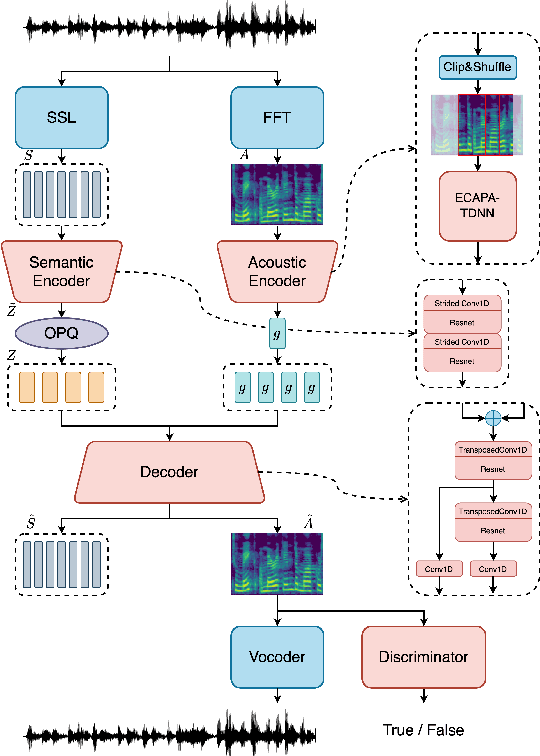

Abstract:The long speech sequence has been troubling language models (LM) based TTS approaches in terms of modeling complexity and efficiency. This work proposes SoCodec, a semantic-ordered multi-stream speech codec, to address this issue. It compresses speech into a shorter, multi-stream discrete semantic sequence with multiple tokens at each frame. Meanwhile, the ordered product quantization is proposed to constrain this sequence into an ordered representation. It can be applied with a multi-stream delayed LM to achieve better autoregressive generation along both time and stream axes in TTS. The experimental result strongly demonstrates the effectiveness of the proposed approach, achieving superior performance over baseline systems even if compressing the frameshift of speech from 20ms to 240ms (12x). The ablation studies further validate the importance of learning the proposed ordered multi-stream semantic representation in pursuing shorter speech sequences for efficient LM-based TTS.
UniAudio 1.5: Large Language Model-driven Audio Codec is A Few-shot Audio Task Learner
Jun 14, 2024



Abstract:The Large Language models (LLMs) have demonstrated supreme capabilities in text understanding and generation, but cannot be directly applied to cross-modal tasks without fine-tuning. This paper proposes a cross-modal in-context learning approach, empowering the frozen LLMs to achieve multiple audio tasks in a few-shot style without any parameter update. Specifically, we propose a novel and LLMs-driven audio codec model, LLM-Codec, to transfer the audio modality into the textual space, \textit{i.e.} representing audio tokens with words or sub-words in the vocabulary of LLMs, while keeping high audio reconstruction quality. The key idea is to reduce the modality heterogeneity between text and audio by compressing the audio modality into a well-trained LLMs token space. Thus, the audio representation can be viewed as a new \textit{foreign language}, and LLMs can learn the new \textit{foreign language} with several demonstrations. In experiments, we investigate the performance of the proposed approach across multiple audio understanding and generation tasks, \textit{e.g.} speech emotion classification, audio classification, text-to-speech generation, speech enhancement, etc. The experimental results demonstrate that the LLMs equipped with the proposed LLM-Codec, named as UniAudio 1.5, prompted by only a few examples, can achieve the expected functions in simple scenarios. It validates the feasibility and effectiveness of the proposed cross-modal in-context learning approach. To facilitate research on few-shot audio task learning and multi-modal LLMs, we have open-sourced the LLM-Codec model.
 Add to Chrome
Add to Chrome Add to Firefox
Add to Firefox Add to Edge
Add to Edge